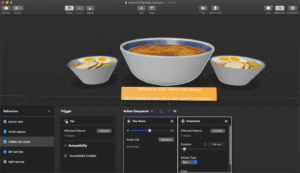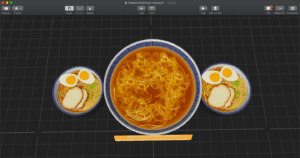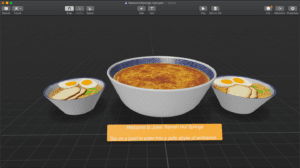For my first AR project, I wanted to create something that incorporates something I just love so much: noodles. (It’s a bit embarrassing to admit, but I eat noodles at least once every few days…) Being in Shanghai for the last few years and growing up in an Asian household, noodles have become a staple for me.
Initially, I wanted to create an experience where you could walk into a bowl of ramen and sit down in it, but I wasn’t sure how to make a bowl so big or do that, so I had to scale back my idea. Instead, I created large bowls of ramen that would embody the essence of an experience eating ramen in a restaurant. Covid has made me nostalgic about dining out at some of my favorite ramen spots and I wanted to create an experience that could bring me back to that ambience and environment.
I got the ramen figures from Reality Composer’s food section, and chose different styles. I also included a little banner in front of the bowls to explain what to do once you’re in the AR world. With each bowl of ramen, you tap on it and an associated sound or ambience plays along with a movement behavior to indicate the user has indeed tapped on the bowl. The first image shows how I was able to merge the behaviors together so that both behaviors would go off at the same time, rather than sound first than movement. The second image shows a bird eye view of the ramen. The third image shows what the user will see at first.



Here is the link to a screen recording on my phone in AR: https://youtu.be/mpJ4nd2ef5k
In the future, I would have liked to pursue my original idea of creating a giant bowl of ramen where the user could “walk into” because that would have just been such a dream for ramen lovers! I think a lot of the process of creating this experience was largely based on just exploring what RC was and how to use it. I was especially confused with the anchor aspect and how to maneuver around that, so that ended up taking a lot of time. After I gain more knowledge about RC, I would like to continue with this project!